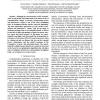ASYNC
2006
IEEE
14 years 6 months ago
2006
IEEE
Distributed sensor networks, human body implants, and hand-held electronics have tight energy budgets that necessitate low power circuits. Most of these devices include an analog-...
AHS
2006
IEEE
14 years 6 months ago
2006
IEEE
Adaptive antenna technology represents the most advanced smart antenna approach to date. Using a variety of new signal-processing algorithms, the adaptive system takes advantage o...
IPSN
2007
Springer
14 years 6 months ago
2007
Springer
We present SPOT, a scalable power observation tool that enables in situ measurement of nodal power and energy over a dynamic range exceeding four decades or a temporal resolution ...
SECON
2007
IEEE
2007
IEEE
Experimental Investigation of IEEE 802.15.4 Transmission Power Control and Interference Minimization
14 years 6 months ago
Abstract—Although the characteristics of RF transmissions are physically well understood at the lowest levels of communication design, accurately incorporating power and interfer...
SECON
2008
IEEE
14 years 6 months ago
2008
IEEE
—Energy-efficient performance is a central challenge in sensor network deployments, and the radio is a major contributor to overall energy node consumption. Current energyeffic...
ISQED
2008
IEEE
14 years 6 months ago
2008
IEEE
Off-chip communication consumes a significant part of main memory system power. Existing solutions imply the use of specialized memories or assume error free environments. This i...
ICCD
2006
IEEE
14 years 8 months ago
2006
IEEE
—Reducing energy consumption is an important issue for battery powered embedded computing systems. Content Addressable Memory (CAM)-based Highly-Associative Caches (HAC) are wide...
DAC
2003
ACM
15 years 25 days ago
2003
ACM
In this work, we report on an unprecedented design where digital, analog, and MEMS technologies are combined to realize a generalpurpose single-chip CMOS microsystem. The converge...
DAC
1998
ACM
15 years 25 days ago
1998
ACM
Power consumption has become one of the biggest challenges in high-performance microprocessor design. The rapid increase in the complexity and speed of each new CPU generation is ...




